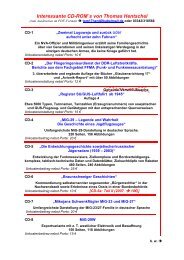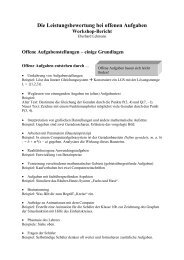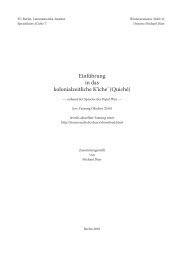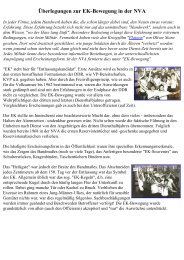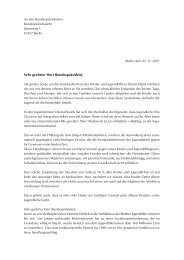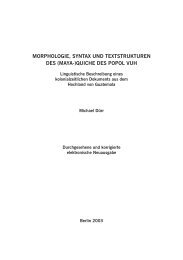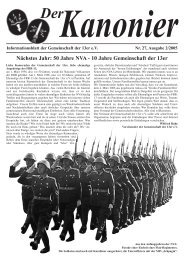SHADOW BOXING: INDONESIAN WRITERS ... - home . snafu . de
SHADOW BOXING: INDONESIAN WRITERS ... - home . snafu . de
SHADOW BOXING: INDONESIAN WRITERS ... - home . snafu . de
You also want an ePaper? Increase the reach of your titles
YUMPU automatically turns print PDFs into web optimized ePapers that Google loves.
Shadow Boxing 165<br />
away from sastra as a crucial manifestation of national culture. The latter effect<br />
could only please the authorities who were eager to silence discussion on the<br />
literary front [. . .] Censorship, invisibly and facelessly operating along various<br />
patterns of power, has done an excellent job; literary life has eliminated itself as<br />
a force for vociferous dissent, leaving only some authors and writers wan<strong>de</strong>ring<br />
on the savannas [...] where they run the risk of being ma<strong>de</strong> criminals. 28<br />
Admittedly, the consequences of the New Or<strong>de</strong>r regime's policies on freedom of<br />
expression by artists, and Indonesian society at large, were more negative than<br />
positive. Furthermore, the image of Indonesian authors and writers wan<strong>de</strong>ring on the<br />
savannas, an image borrowed from the man that many regard as Indonesia's greatest<br />
author, Pramoedya Ananta Toer, is apt. Nevertheless, after surveying the savannas<br />
carefully, literary life in the New Or<strong>de</strong>r was surely not as hopeless as Maier suggests.<br />
For example, <strong>de</strong>spite Maier's low regard for writers "rejecting realism and strict<br />
moralism," surrealist writers such as Putu Wijaya, Danarto, and Seno Gumira<br />
Ajidarma, supposedly "preoccupied with an experimental freedom and playfulness,"<br />
were in their own oblique way just as oppositional and political as their realist<br />
counterpart, Pramoedya. 29<br />
Importantly, those writers seeking to critique Suharto and his regime—such as the<br />
surrealist writers mentioned above and others such as Nano Riantiarno, Y. B.<br />
Mangunwijaya, and Emha Ainun Nadjib—were, at one stage or another, provoked into<br />
veiling their meanings by ingeniously <strong>de</strong>veloping techniques that J. M. Coetzee terms<br />
"Aesopian ruses." 30 Although the New Or<strong>de</strong>r's system of control and censorship was<br />
not quite as well-regulated as those found within a totalitarian regime such as the<br />
Soviet Union, writers in the New Or<strong>de</strong>r, especially during the latter years, worked<br />
un<strong>de</strong>r a shadow of fear: arrests, <strong>de</strong>tentions, and bannings of books and performances<br />
were common. Attempts to outwit the authorities also became a popular occupation,<br />
and the most popular "ruse" was to turn to Java and its pre-eminent cultural<br />
expression, the wayang. This is because for centuries the dalang or wayang puppeteer<br />
has inserted contemporary references and social commentary into the wayang tales.<br />
Furthermore, the critical impact of the wayang as a literary form is even more<br />
significant because of the way wayang figured so prominently in New Or<strong>de</strong>r i<strong>de</strong>ology<br />
as a symbol of Suharto's Java-based and Javanese-dominated governmental ties to<br />
tradition and enduring hierarchical values. 31 1 would argue, therefore, that one of the<br />
28 Ibid., p. 258.<br />
29 See Paul Tickell, "Subversion or Escapism? The Fantastic in Recent Indonesian Fiction," Review of<br />
Indonesian and Malay Affairs 20,1 (1986): 50-76; Paul Tickell, "Writing the Past: The Limits of Realism in<br />
Contemporary Indonesian Revolution/' in Text/Politics in Island Southeast Asia, ed. D. M. Roskies (Athens,<br />
Ohio: Center for International Studies, Ohio University, 1993), pp. 257-287; Michael H. Bod<strong>de</strong>n, "Seno<br />
Gumira Ajidarma and Fictional Resistance to an Authoritarian State in 1990s Indonesia," Indonesia 68<br />
(October 1999): 153-156; and Marshall Clark, "Seno Gumira Ajidarma: an Indonesian Imagining East<br />
Timor," Review of Indonesian and Malaysian Affairs 33,2 (Summer 1999): 33-58.<br />
30 J. M. Coetzee, Giving Offense: Essays on Censorship (Chicago: University of Chicago Press, 1996), p. 11.<br />
31 See Michael van Langenberg, "The New Or<strong>de</strong>r State: Language, I<strong>de</strong>ology, Hegemony," in State and Civil<br />
Society in Indonesia, ed. Arief Budiman (Clayton, Victoria, Australia: Centre of Southeast Asian Studies,<br />
Monash University, 1990), p. 134; Michael H. Bod<strong>de</strong>n, "Teater Koma's Suksesi and Indonesia's New<br />
Or<strong>de</strong>r," Asian Theatre Journal 14,2 (1997): 267; and Barbara Hatley, "Constructions of Tradition' in New



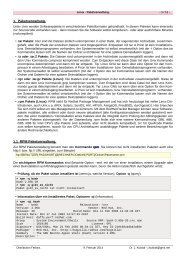
![Parameterdarstellungen [ x(t), y(t) ] Eberhard ... - home . snafu . de](https://img.yumpu.com/22517728/1/184x260/parameterdarstellungen-xt-yt-eberhard-home-snafu-de.jpg?quality=85)
